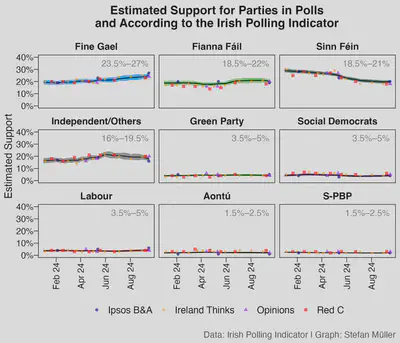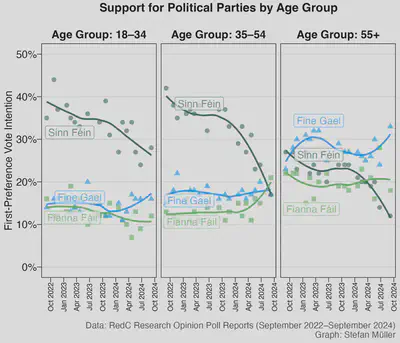Irish Polling Indicator, update September 2024

Recent polls reveal significant shifts in party support as Ireland approaches its next General Election. Fine Gael has seen an increase in popularity following a change in leadership. At the same time, Sinn Féin has experienced a notable decline across all age groups. The data also highlight persistent generational divides in party preferences, with older voters favouring Fine Gael and younger voters still leaning towards Sinn Féin, albeit much less strongly than before. With around half of the electorate typically making their decision in the month leading up to an election, campaigning efforts and unforeseen developments may sway the outcome.
Trends and Current Levels of Party Support
The trends based on the Irish Polling Indicator since January 2024 show positive momentum for Fine Gael and a significant decline for Sinn Féin. Fine Gael has experienced a notable upswing following Simon Harris’s appointment as Taoiseach. The party climbed from roughly 18%–21% support in January to 23.5%–27% in September. Conversely, Sinn Féin has witnessed a substantial decline over the same period, dropping from a comfortable lead in January (29%–31%) to 18.5%–21% in September. The four polls conducted in September 2024 have Sinn Féin between 18% and 20%. In the same polls, support for Fine Gael ranges between 23% and 27%. Either all pollsters are wrong about Sinn Féin and Fine Gael, or the snapshot mirrors reality.
Fianna Fáil has maintained a relatively stable position, consistently polling around 18%–21% throughout this period, with a small upswing since the Local and European Parliament Elections. Fianna Fáil could benefit from their popular and well-known incumbents, though. The party often outperforms polls due to candidates with strong local ties and name recognition, in addition to a well-organised party machine. The robust incumbency advantage in Ireland might pose a challenge for Fine Gael, as 17 of its 35 TDs will not stand for re-election.

Independents and other parties collectively account for approximately 16%–19.5% of the vote share. Support for Independent Ireland, currently included in Other Parties, has been reported in only a few polls. The latest RedC poll puts Independent Ireland at around 4%. The Green Party, Social Democrats, and Labour each maintain the support of approximately 3.5%–5%, while Aontú and Solidarity-PBP stand between 1.5%–2.5% each. The figure above also indicates a lot of continuity. Except Sinn Féin (downward trend) and Fine Gael (upward trend since April), support for all parties and Independent candidates is quite similar to the beginning of the year.
Age-Based Voting Patterns
The demographics of party support reveal stark generational divides. Based on RedC Research Opinion Poll Reports, the figure below illustrates the rapid decline of support for Sinn Féin over the past two years. While the party still polls strongest among younger voters, support has now dropped well below 30% after reaching nearly 40% at the start of the year. The decline in Sinn Féin support is most pronounced in the 35–54 age group, where support has dropped from the mid- to high-30s to around 20%. Among the oldest voter group (55+), Sinn Féin now ranks a distant third, with current support levels of around 15%. The Ireland Thinks online exit survey for the 2024 Local Elections and the latest Ipsos/B&A poll in the Irish Times further support these trends. So far, Sinn Féin’s housing plan appear unsuccessful at winning back support amongst younger voters, who are acutely affected by the ongoing crisis. The rise of immigration as a salient issue resulted in further, possibly even more severe, challenges for the party. Comparing recent survey data, political scientist Rory Costello showed that Sinn Féin support fell strongly among anti-immigration voters.

Fine Gael, by contrast, finds its stronghold among older voters, with robust support of around 30% in the 55+ demographic. This support base remains significantly stronger than their appeal to younger age groups, highlighting a clear generational preference. The “Harris bounce” seems to be largely driven by older voters, which could be a significant advantage for Fine Gael, given that older citizens are much more likely to turn out on election day.
Election Timing and Volatility
Nevertheless, election timing matters. Political scientists Petra Schleiter and Margit Tavits conducted conducted comparative research on the electoral benefits of calling elections strategically. Their analysis of 318 parliamentary elections in 27 European countries revealed a bonus of 5 percentage points if the incumbent government calls an election strategically. However, Fine Gael has been unable to capitalise on this bonus in the last two elections. As Eoin O’Malley points out: “Enda Kenny waiting until 2016 and Leo Varadkar’s decision not to call an election in 2018 when he and Fine Gael were very popular are seen as strategic mistakes.” Current trends favour Fine Gael and suggest a continuation of a Fine Gael/Fianna Fáil coalition (potentially with a third party), but we know that the Irish electorate is volatile.

An analysis by Kevin Cunningham and Michael Marsh based RTÉ Exit Polls from 1997 to 2020 highlights the importance of the campaign period. Across those six general elections, 13% of respondents made up their minds about their first-preference vote choice on the day of the election or the day before. An additional 17% decided during the week of the election, while 25% decided in the last 2–3 weeks before the election.
This means that less than half of the electorate, according to self-reported data in exit polls, had made up their minds before the election was called. Importantly, the high proportion of late deciders is not a new phenomenon but has been a feature of Irish elections for a long time. The question of when to call the election is crucial. Still, the campaign period or unforeseen developments could be even more significant.
Interactive graphs and details on the methodological approach can be found on the Irish Polling Indicator Website. I thank the polling companies and newspapers for making fine-grained data available. Without their surveys and reports, projects like the Polling Indicator and the analysis of trends would not be possible.
Author: Stefan Müller